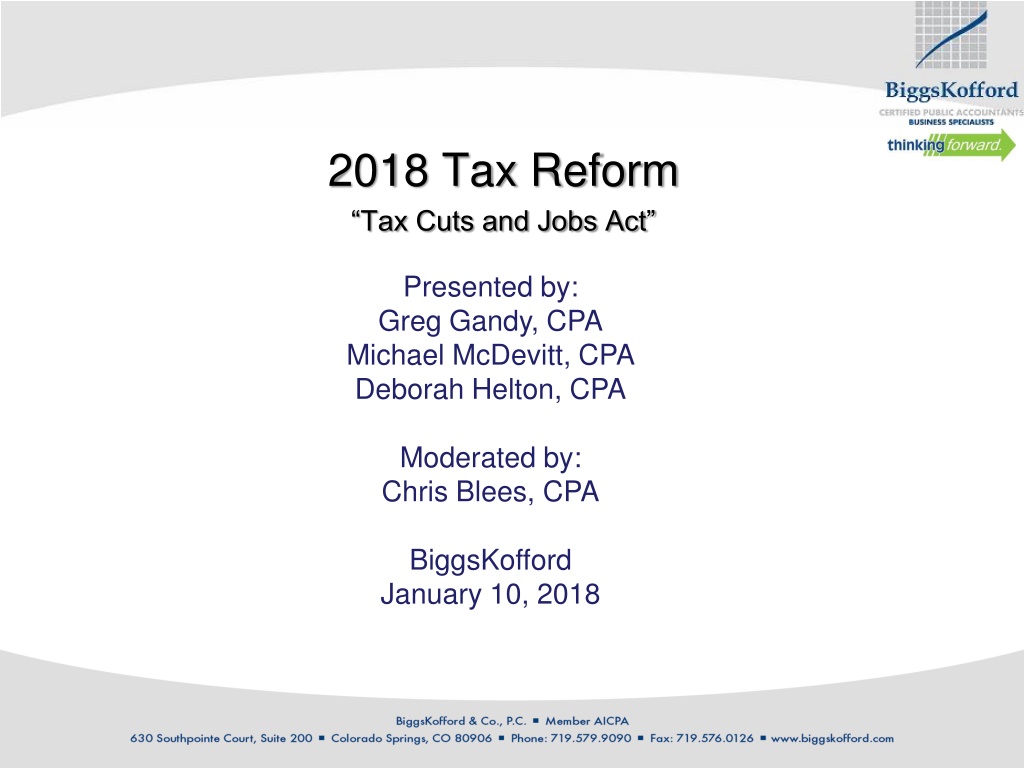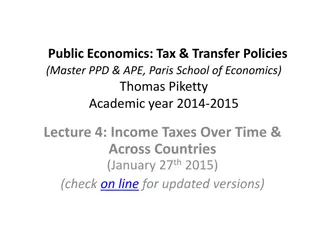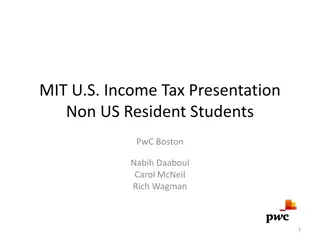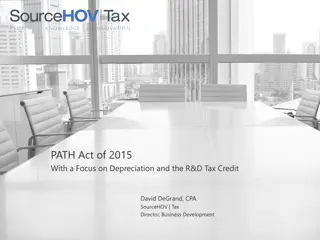
Tax Reform and Jobs Act Overview 2018
Gain insights into the key provisions of the 2018 Tax Reform and Jobs Act, including changes to individual taxes, alternative minimum tax, estate tax, investment income, and standard deduction/personal exemptions. Understand the potential impact on businesses and households.
Download Presentation

Please find below an Image/Link to download the presentation.
The content on the website is provided AS IS for your information and personal use only. It may not be sold, licensed, or shared on other websites without obtaining consent from the author. If you encounter any issues during the download, it is possible that the publisher has removed the file from their server.
You are allowed to download the files provided on this website for personal or commercial use, subject to the condition that they are used lawfully. All files are the property of their respective owners.
The content on the website is provided AS IS for your information and personal use only. It may not be sold, licensed, or shared on other websites without obtaining consent from the author.
E N D
Presentation Transcript
2018 Tax Reform Tax Cuts and Jobs Act Presented by: Greg Gandy, CPA Michael McDevitt, CPA Deborah Helton, CPA Moderated by: Chris Blees, CPA BiggsKofford January 10, 2018
Enterprise Edge Trump Presidency Impact to Closely Held Business Owner Presented by: Chris Blees, CPA President & CEO, BiggsKofford January 11, 2017
Individual Taxes Brackets and Rates Ryan Plan Initial Trump Plan Revised Trump Plan 3 Brackets: 12%, 25%, & 33% 3 Brackets: 10%, 20%, & 25% 3 Brackets: 12%, 25%, & 33% Would likely just eliminate top brackets
Alternative Minimum Tax Initial Trump Plan Eliminated Revised Trump Plan Eliminated Ryan Plan AMT Eliminated Eliminating AMT could be substantial for $200k-500k households
Estate Tax, Generation-Skipping Transfer Tax Initial Trump Plan Revised Trump Plan Eliminated, but capital gains above $5 million/ $10 million would be taxed at death Ryan Plan Eliminated Estate Tax Eliminated Generation Skipping Transfer Tax Eliminated Eliminated Eliminated Estate Tax may be difficult to completely eliminate. Complete elimination may indirectly increase capital gains.
Investment Income Ryan Plan 50% deduction on capital gains, dividends and interest income Resulting in rates 6% 12.5% 16.5% Initial Trump Plan Revised Trump Plan Maximum rate of 20% on capital gains/dividends Repeal Obamacare surtax Tax Carried Interest as normal income Retain current structure, but repeal Obamacare surtax Tax Carried Interest as normal income Seems likely to keep current structure, less Obmacare tax
Standard Deduction / Personal Exemptions Ryan Plan Increase standard deduction Single - $12,000 Single w/children - $18,000 Couples filing jointly (indexed to inflation) - $24,000 Initial Trump Plan Increase standard deduction of $25,000/$50,000 Retains existing personal exemptions, but steepens curve on Personal Exemption Phase-out Revised Trump Plan Increased standard deduction Single - $15,000 Married Couples - $30,000 Eliminates personal exemptions Eliminates head-of- household filing status
Child Tax Credit Ryan Plan Consolidate CTC & dependent exemptions into $1,500 (first $1,000 refundable) Non-refundable $500 credit for non-child dependents Increase phase-out threshold for married couples from $110K to $150K Requires SSN for refundable portion of credit *Initial and Revised Trump Plans - No Information
Itemized Deductions Ryan Plan Eliminate all except Mortgage Interest Deduction and Charitable Contributions deduction (both with unspecified reform to make them more effective and efficient ) Initial Trump Plan Revised Trump Plan Increase phase-out deductions (steepen curve of Pease limitation) on all except Mortgage Interest Deduction and Charitable Contributions Capped at $100,000/$200,000 What about state taxes?
Retirement Saving Incentives Ryan Plan Unspecified consolidation/reform *Initial and Revised Trump Plans No Information Needs consolidation / reform
Pass-Through Entities/Sole Proprietorships Ryan Plan Initial Trump Plan Revised Trump Plan Unclear whether pass- through would be eligible for 15% rate. Plan says that rate would be available to all businesses, both small and large, that want to retain the profits within the business so may just apply to C corps but pass- throughs may be able to elect to adopt a status similar to C corps. Top rate of 25% Compensation to owner- operators deductible and taxed at individual rates Full expensing allowed on tangible & intangible assets 15% rate Lower rates for S-Corp earnings could raise S-Corp SE tax issues
Corporate Tax Rate & Corporate AMT Ryan Plan Initial Trump Plan 15% Eliminated Revised Trump Plan 15% Eliminated Rate 20% Corporate AMT Eliminated These are primarily benefiting large corporations But, depending on dividend rates, this could create planning opportunities for closely-held business owners.
Depreciation Ryan Plan Initial Trump Plan No Information Revised Trump Plan Manufacturing firms can elect full expensing in exchange for forgoing interest deduction Full Expensing Allowed Sounds like expansion of Section 179
Tax Cuts & Jobs Act December 22, 2017 - President Trump signed into law. Unless otherwise noted, these provisions take affect after 12/31/17. Not all of the changes are permanent. Most of the individual provisions end after 2025. How will the states react? What about a technical corrections bill? What can we expect from the IRS? This is NOT an exhaustive discussion on all provisions of the Act. We have included only those provisions we felt applied to most of you in the audience. If you have any questions on items in the Act we don t cover, see us after the presentation.
Tax Cuts & Jobs Act Summary 1. Simplification? (Not for Business Owners) 2. Certainty? (Not Yet) 3. Good News? (For most but not all) 4. Planning becomes even more important.
Provisions Not Enacted Repeal of the Credit for the Elderly and Permanently Disabled Repeal of the Plug In Electric Credit Repeal of the Tax Credit for Mortgage Credit Certificates Procedures to reduce improper claims of the EITC Reform of the American Opportunity Credit and repeal of the Lifetime Learning Credit Repeal of the deduction for student loan interest Repeal of the deduction for qualified tuition and related expenses Repeal of the exclusion for qualified tuition reductions Repeal of the interest free exclusion on EE savings bonds used for education Repeal of the $5,250 exclusion for educational assistance programs Disallowance of contributions to MSA's Disallowance of deduction for performing artists and educators Limitation for exclusion on employer provided housing Modification on the exclusion of gain for a principal residence
Provisions Not Enacted Repeal of exclusion for dependent care assistance programs Repeal of exclusion for Adoption Assistance Programs Reduction in minimum age for allowable government in service distributions Change in the rules for Hardship Distributions Modification of Non Discrimination Rules Modification of IRS user fee agreements Attorney fees deduction for whistleblowers Clarification of whistleblower awards Repeal of special rule on sale or exchange of patents Denial of attorneys expenses in contingency cases Repeal of Employer provided Child Care Repeal of Work Opportunity Credit Repeal of certain Unused Business Credits Repeal of New Markets Credit Repeal of Disability Access Credit Modification of tip credit Various energy credit provisions Oil and Gas credits Termination of Private Activity Bonds No tax-exempt bonds for professional stadiums
Notable Individual Changes Individual provisions to sunset December 31, 2025
Tax Rates for Individuals Examples Taxable Income $50,000 $250,000 $500,000 $1,000,000 Tax Amount 2017 $6,568 $57,718 $143,231 $341,231 2018 $5,619 $48,579 $126,379 $309,379 Reduction -14% -16% -12% -9%
Tax Rates for Individuals 2017 Tax Rates Married Filing Joint: Taxable income 2018 Tax Rates Married Filing Joint: Taxable income From To $18,650 $75,900 $153,100 $233,350 $416,700 $470,700 Tax Rate 10% 15% 25% 28% 33% 35% 39.6% From To $19,050 $77,400 $165,000 $315,000 $400,000 $600,000 Tax Rate 10% 12% 22% 24% 32% 35% 37% 0 $0 $18,650 $75,900 $153,100 $233,350 $416,700 $470,700 $19,050 $77,400 $165,000 $315,000 $400,000 $600,000 - -
Comparisons $250,000 and lower
Capital Gains Rules Capital Gains: The basic rules on capital gains and Qualified Dividends remain the same. For married filing jointly, the 2018 tax rates for long term capital gain & qualified dividends are: 0% bracket up to $77,400 of taxable income. 15% bracket from $77,400 to $480,050 of taxable income. 20% bracket above that.
Estate & Gift Tax Increase in Exemption: For deaths from 1/1/2018 through 12/31/2025, the basic exemption is doubled and continues to be increased for inflation. In 2018, the exemption is $5,600,000 x 2= $11,200,000. For 2017, the exemption was $5,490,000. No changes to discounting were included in the law.
Alternative Minimum Tax The exemptions are increased: 2017 $86,200 $55,400 2018 $109,400 $70,300 MFJ Single Note: Since state & local taxes itemized deductions are capped at $10,000 (discussed later), there will be far fewer taxpayers subject to AMT in 2018. The Exemption Phase outs are increased (beginning points below): 2017 $164,100 $1,000,000 $123,100 2018 MFJ Single $500,000
Affordable Care Act (Obamacare) The amount of the penalty imposed on individuals without health insurance is zero. For months beginning after December 31, 2018, the amount a taxpayer would otherwise owe for each month they fail to have "minimum essential coverage" for themselves and their dependents is zero. The 3.8% Net Investment Income Tax and the 0.9% Additional Medicare tax remain
Standard Deduction Doubled For tax years from 2018 to 2025, the basic standard deduction amounts are doubled: $12,000 for single individuals and married individuals filing separately; $18,000 for heads of household; and $24,000 for married individuals filing jointly. Personal & Dependency Exemptions are temporarily repealed for tax years from 2018 to 2025. Planning Note: With state tax deductions limited, taxpayers with large charitable contributions may consider bundling donations into one year using a Donor Advised Fund and claim standard deductions in other years.
Child Tax Credit The child tax credit is temporarily expanded effective for tax years from 2018 to 2025: The credit amount is increased to $2,000 per qualifying child (it was $1,000). The threshold amount when the credit begins to phase out is increased to $400,000 if married filing jointly and $200,000 for any other filing status. (This is phase out is almost four times the old rules.) A taxpayer may claim a $500 credit for each dependent who is not a qualifying child for purposes of the child tax credit. (A dependent for this purpose is a qualifying relative.)
Trading the Exemption for Increased Child Tax Credit Compare to the value of an exemption: 12% x $4,150 = $498 After phase-out compare to the value of an exemption: 32% x $4,150 = $1,328
Section 529 Plans New rules now allow up to $10,000 per year for K-12 private school and qualified home-school expenses. Colorado still allows full deduction for amounts contributed. Planning Note: Parents paying out-of-pocket for private schools or college could contribute to 529 plans and claim state tax deductions, even if the funds are immediately withdrawn for education.
Modifications to Itemized Deductions & Misc.
State & Local Taxes The deduction for taxes is limited to $10,000 for tax years from 2018 to 2025, for the following: State and local real property taxes State and local personal property taxes State and local sales taxes deducted in lieu of state and local income taxes This is for taxes paid or accrued by an individual during the tax year that are not directly connected with a trade or business, or with property held for the production of income. For state income taxes, taxpayers may not prepay 2018 taxes and claim as a 2017 deduction. For property taxes, the IRS has issued guidance that property taxes paid during 2017 will only be allowed, if the taxes were assessed during 2017. Note: This issue created confusion, news articles, and even the IRS weighed-in the week between Christmas and New Years. Although, many taxpayers attempting to pay their taxes early were subject to AMT anyway.
Mortgage Interest The itemized deduction for home mortgage interest is limited for tax years 2018 through 2025: The maximum amount is reduced to $750,000 for any acquisition debt incurred after December 15, 2017. (The old limit was $1 million) The deduction of interest on home equity debt is suspended. The maximum remains $1 million for any acquisition debt incurred with respect to the taxpayer s principal residence on or before December 15, 2017. The higher $1 million limit continues to apply to refinancing done after December 15, 2017, if the new debt does not exceed the amount of the refinanced debt. The Deduction for second homes is still in place. Earlier proposals would have eliminated the deduction for mortgage acquisition indebtedness for a second home. The final version of the law preserves the mortgage interest deduction for a second home.
Mortgage Interest (Special Note) Mortgage proceeds used for a business (or similar) activity. The new mortgage deduction limits apply if the taxpayer uses mortgage loan proceeds to buy, build or substantially improve the taxpayer s home. If a mortgage is secured by the home of the taxpayer, but the proceeds are used to purchase rental property, property used in a trade or business or investment property, then the interest on such a loan can be separately deducted elsewhere on a taxpayer s income tax return. Such interest is not subject to the new mortgage interest deduction limitation, and such loan balances are not counted against the limit.
Medical Expenses Medical expense deduction AGI threshold temporarily reduced The threshold to claim an itemized deduction for unreimbursed expenses paid for the medical care of the taxpayer or the taxpayer's spouse or dependents is reduced to 7.5% of adjusted gross income (AGI) for all taxpayers for tax years 2017 & 2018 (Old rule was 10%).
Charitable Contributions The percentage limitation on the charitable deduction contribution base is increased to 60% of an individual s adjusted gross income (AGI) for cash donations to public charities in 2018 through 2025. (Old rule was 50%) The deduction for amounts paid for college athletic seating rights is repealed. The exception to contemporaneous written acknowledgment requirement for contributions of $250 or more is repealed.
Misc. Itemized Deductions The deductibility of miscellaneous itemized deductions is temporarily repealed for tax years 2018 through 2025. These deductions were subject to the two-percent floor included the following: unreimbursed employee expenses (including expenses for travel, lodging, meals, entertainment, continuing education, subscriptions to professional journals, union or professional dues, professional uniforms, job hunting, and business use of an employee's home). expenses paid or incurred for the production or collection of income (including investment advisory fees, subscriptions to investment advisory publications, certain attorneys fees, and safety deposit box rental), or for the determination, collection, or refund of tax (including tax counsel fees and appraisal fees).
Suspension of Overall Limitation on Itemized Deductions The overall limitation on itemized deductions is suspended, applicable to tax years beginning from 2018 to 2025. Prior to 2018, if an individual s AGI exceeds the applicable threshold amount, he or she must reduce the amount of allowable itemized deductions by the lesser of: (1) three percent of the excess of the taxpayer s AGI over the applicable threshold amount, or (2) 80 percent of allowable itemized deductions, reduced by the deductions for medical expenses, investment interest, casualty and theft losses, and wagering losses. For 2017, the married filing jointly threshold is an AGI of $309,900.
Alimony & Separate Maintenance Payments Alimony deduction and exclusion repealed for instruments executed or modified after 2018. The deduction of alimony and the inclusion of the payments in gross income by the payee are generally repealed after 2018. The repeal is only effective for any divorce or separation instruments: executed after December 31, 2018; and executed before January 1, 2019, and modified after 2018 provided that the modification expressly provides that the repeal of the qualified alimony and separate maintenance rules of the Internal Revenue Code apply.
Moving Expenses For years from 2018 to 2025: The above the line deduction is suspended. The exclusion from income for employer reimbursement is suspended. (The repeal does not apply to members of the Armed Forces on Active Duty who move pursuant to a military order and a permanent change in station.) Away From Home living expense deduction for members of congress: Suspended
Tax Accounting Methods Beginning for tax years beginning after December 31, 2017, the threshold is now $25,000,000 in average annual gross receipts (3-years; 2015-2017) for: Being able to use the cash method of accounting Being required to account for inventory Regardless of financial statement treatment Being subject to UNICAP Being required to use the percentage-of-completion method. Planning Note: Some taxpayers may be able to make a favorable change in accounting method. Worth talking to your CPA!
Domestic Production Activities Deduction (DPAD) Repealed for tax years beginning after December 31, 2017
Meals & Entertainment The law removes the deduction for: An activity generally considered to be entertainment, amusement or recreation (e.g. .football tickets, greens fees), Membership dues with respect to any club organized for business, pleasure, recreation, or other social purposes, or A facility or portion thereof used in connection with any of the above items. Taxpayers may still deduct 50% of the food and beverage expenses associated with operating a trade or business.
Like-Kind Exchange (1031) Like-kind exchanges are allowed only for real property after 2017. No longer allowed for personal property (cars, trucks, equipment, etc.)
Limitation on Deduction of Business Interest New limitation on interest expense for businesses with average annual gross receipts of $25,000,000 or more After December 31, 2017, the deduction for business interest is limited to the sum of: Business interest income; 30% of the adjusted taxable income of the taxpayer; and The floor plan financing interest of the taxpayer Excess business interest deductions are carried forward indefinitely Excess business interest of a passthrough entity is carried over by partners, members and shareholders and not the entity. An election out is available for real estate development, construction, etc. For interest that is not required to be capitalized Does not apply to investment interest expense Adjusted Taxable Income is basically EBITDA.
Passthrough Deduction Officially called Qualified Business Income Deduction - Section 199A A new 20% deduction of domestic Qualified Business Income ( QBI ) is allowed for individuals, Estate and Trusts that own Partnerships, S Corporations and Sole Proprietorships. The deduction applies to tax years beginning after December 31, 2017, and before January 1, 2026. Although the deductions is generally based on business income, it is taken against Taxable Income (Page 2 of Form 1040). Deduction is available for both itemizers and non-itemizers. Note: There are new terms to learn and plenty of limitations, calculations and restrictions.
Passthrough Deduction The deduction is not necessarily 20% of QBI as it is ultimately limited to 20% of taxable income over net capital gains Deduction IS allowed in the computation of Alternative Minimum Taxable Income. As taxable income exceeds certain thresholds, the deduction is limited or subject to additional restrictions: $315,000 - $415,000 for MFJ, and $157,500 - $207,500 for other taxpayers.



![Town of [Town Name] Real Estate Tax Rates and FY 2024 Budget Summary](/thumb/62211/town-of-town-name-real-estate-tax-rates-and-fy-2024-budget-summary.jpg)


















